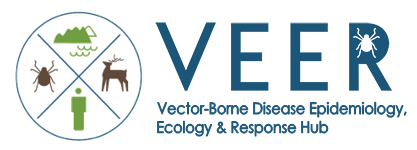Research at VEER
Research at VEER
Effect of Tick-Borne Rickettsia Infections On Pregnancy and Birth Outcomes
Aim:
Estimate the seroprevalence of Spotted Fever Group Rickettsia (SFGR) infections and examine potential risks of adverse pregnancy and birth outcomes in central North Carolina.
- Determine the seroprevalence of tick-borne Spotted Fever Group Rickettsia (SFGR) infection among a population-based cohort of pregnant women in central NC, an area highly endemic for SFGR.
- Estimate the risk for adverse pregnancy and birth outcomes among women with evidence of prior SFGR infection compared to women without evidence of prior infection.
Funding:
Carolina Population Center, University of North Carolina at Chapel Hill
Principal Investigator(s):
Ross Boyce (UNC)
Lyme Disease in Western North Carolina
Aim:
First Arm:
- Evaluate frontline clinicians’ knowledge of Lyme disease prevention, transmission, clinical manifestations, and management.
- Quantify clinicians’ experience with patients seeking care for Lyme and other tick-borne diseases.
- Document resource gaps, such as access to specialist care and perceived challenges in clinical practice identified by frontline providers.
Second Arm:
- Quantify year-to-year changes in (i) the seroprevalence of Lyme antibodies as detected by a point-of-care test kit and (ii) the number incident seroconversions of canine Lyme disease in Watauga County, North Carolina from 2017 to 2021.
- Identify clusters of canine Lyme disease test positivity in Watauga County and asses the environmental, ecological, and geospatial covariates associated with hotspots.
- Determine trends in human Lyme disease in Watauga County as reported through routine surveillance systems and antibiotic (doxycycline) prescriptions.
Funding:
Office of the Vice Chancellor for Research, University of North Carolina at Chapel Hill
Principal Investigator(s):
Ross Boyce (UNC)
Seroprevalence of Tick-Borne Diseases Including Alpha-gal Allergy and Associations With Musculoskeletal Symptoms in a Population-Based Cohort in Central North Carolina
Aim:
Assess the seroprevalence of tick-borne diseases as well as Alpha-gal syndrome from a serum biorepository of the Johnston County Arthritis Cohort.
Funding:
Office of the Vice Chancellor for Research, University of North Carolina at Chapel Hill
Principal Investigator(s):
Ross Boyce & Scott Commins (UNC)
La Crosse Encephalitis Virus in Western North Carolina
Aim:
Build the appropriate infrastructure and collect critical preliminary data that will lay the foundation for future efforts to improve the effectiveness of care for patients hospitalized with LACV infection and reduce disease transmission in the community.
- Implement a prospective, longitudinal cohort of pediatric patients admitted to Mission Hospital with symptoms consistent with LACV infection.
- Describe the (i) demographic characteristics, clinical history, and laboratory results, (ii) diagnostic testing performed and treatments administered, and (iii) clinical outcomes of patients admitted with LACV infection.
- Estimate temporal and geographic risk factors associated with the participant household to guide targeted interventions.
Funding:
North Carolina Collaboratory
Principal Investigator(s):
Ross Boyce (UNC), Brian Byrd (WCU)

Estimating the Incidence Of and Risk Factors For Tick-Borne Disease in Central North Carolina
Aim:
Describe the clinical spectrum of disease among individuals with tick-borne disease, explore potential alternative diagnostic methods for Spotted Fever Group Rickettsial diseases and Ehrlichia, define risk factors for tick-borne disease, and build a biorepository of specimens from patients suspected of having tick-borne disease.
Funding:
Centers for Disease Control, NC Division of Public Health
Principal Investigator(s):
Dr. Ross Boyce, Co-Investigators: Kim Brownley, Scott Commins, Brandon Hollingsworth, Amanda Brown Marusiak, Aidin Alejo
Modeling the Risk of Vector-Borne Disease in North Carolina
Aim:
Quantify and model the spatio-temporal risk of select vector-borne diseases of public health importance (e.g. Rocky Mountain Spotted Fever) across the state of North Carolina, using a wide range of existing, multidisciplinary data sets.
- Determine the environmental, ecological, socio-demographic, and behavioral (i.e. crowd-sourced information) covariates associated with geographic areas of high VBD test positivity and vector abundance in North Carolina.
- Determine the correlation between vector presence/abundance and VBD test positivity rates in North Carolina.
- Develop a model for the risk of VBD infection based on ecological and entomological covariates and crowd-sourced platforms.
Funding:
Office of the Vice Chancellor for Research, University of North Carolina at Chapel Hill
Principal Investigator(s):
Dr. Ross Boyce, Co-Investigators: Michael Reiskind, Alun Lloyd, Michael Emch, Erika Wise, Alan Kinlaw, Brandon Hollingsworth, Amanda Brown Marusiak

Temporal Trends in Tick-Borne Disease Infection Among Soldiers Stationed at Fort Bragg, North Carolina: Changing climate, changing vectors, changing risk
Aim:
- Determine temporal trends in the prevalence of endemic tick-borne infections in NC over the past 30 years.
- Describe the emergence and prevalence of alpha-gal syndrome (aka the red meat allergy) among soldiers stationed at Fort Bragg available in the Department of Defense (DoD) serum repository.
- With remaining sera, explore the prevalence of antibodies against Powassan virus, a tick-borne flavivirus known to cause severe and debilitating neuro-invasive disease.
Funding:
Office of the Vice Chancellor for Research, University of North Carolina at Chapel Hill
Principal Investigator(s):
Dr. Ross Boyce, Co-Investigators: Carlos Maldonado, Scott Commins
